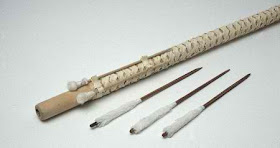MANIK pinakol dan rantai yang sering dijadikan hiasan untuk dipakai wanita Sabah dari suku kaum Rungus ketika majlis keramaian (gambar)
 |
| Pinakol |
DI rumah panjang itulah dia dibesarkan dan belajar mengenal erti hidup. Rumah panjang yang terletak di Kampung Tinangol, Kudat, Sabah itu memang terpencil dan sukar untuk dijejaki jika tiada pemandu pelancong yang membawanya. Namun di situlah tempat Erllin Agunchai, 25, membesar dan menghabiskan hampir seluruh waktu siangnya membuat kraftangan yang berasaskan manik.
Berpusat di sebuah bengkel yang didirikan khas, setiap hari Erllin bersama dua anak perempuannya, Elvera, 6, dan Elfey Ferra, 2, akan membuat kraftangan manik. Di situlah juga manik yang telah dicantumkan menjadi barangan perhiasan akan dijual kepada pelancong yang sampai ke kampung mereka.
Sejak berusia 13 tahun lagi Erllin telah membuat gelang maniknya sendiri, namun gelang maniknya itu musnah dalam kebakaran yang berlaku di kediamannya beberapa tahun lalu.
Bukan dipaksa atau terpaksa, minat membuat kraftangan manik sememangnya terbit secara semula jadi dalam diri ibu muda ini. Sebab itulah dalam sehari Erllin mampu menghasilkan lebih dari tiga perhiasan yang diperbuat daripada manik. Sebagai suri rumah dan pengusaha manik sepenuh masa, Erllin mampu memperoleh pendapatan sebanyak RM200 hingga RM300 sebulan.
Jumlah itu bukan sahaja cukup untuk menampung kehidupan malah memberi Erllin peluang merencanakan masa depan anak-anaknya dengan menabung pendapatan yang diperoleh hasil dari menjual manik kraftangan beliau.
Ia menjadi pelengkap kepada pendapatan suaminya, Edmund Polipus, 30, yang bertugas sebagai guru untuk menampung kehidupan mereka berempat.
Bukan Erllin sahaja, malahan neneknya, Ombuong Musodong, 65, ibu saudara, sepupu serta rakan-rakan Erllin turut terlibat dalam bisnes yang sama dengannya. Pendek kata setiap wanita di kampung itu semuanya memiliki kemahiran membuat kraftangan manik dan meneruskan tradisi itu secara beramai-ramai.
“Kenangan yang paling tidak dapat dilupakan sejak memulakan perusahaan ini ialah apabila mendapat tempahan pinakol (manik yang dibuat berbentuk rantai) sebagai cenderamata untuk seorang paderi.
“Ia dijual dengan harga RM150, yang paling mahal pernah saya jual sepanjang terlibat dalam bidang ini,” jelas Erllin yang ditemui di bengkel kraf Kampung Tinangol, baru-baru ini.
Erllin berkata, hampir 100 wanita di kampungnya akan bekerjasama membuat manik sekiranya mendapat tempahan. Mereka tidak pernah bersikap mementingkan diri sendiri malah setiap keuntungan dibahagikan sama rata sesama mereka.
“Paling menarik, para suami akan turut menolong kiranya para isteri tidak mampu menguruskan tempahan yang banyak,” ujar Erllin dalam loghat Sabah yang mudah difahami.
Setiap corak yang dihasilkan adalah mengikut kreativiti mereka sendiri. Perhiasan seperti rantai dibahagikan beberapa nama seperti litai Sabah, litai Venusak, tinutu (corak tradisi), inavol dan pinakol.
Menurut Erllin, pinakol paling sukar dihasilkan kerana ia memerlukan ketelitian serta kesabaran yang tinggi.
“Pinakol ini pula terbahagi dua iaitu yang jenis bersilang dan yang kedua biasanya digunakan pada tradisi perkahwinan suku kaum Rungus di Kudat,” jelas Erllin.
Antara produk daripada manik yang dihasilkan termasuklah gelang, rantai, kerongsang, balutan pen dan macam-macam lagi.
Mengikut bancian yang dijalankan oleh Kraftangan Malaysia, perusahaan manik merupa
 |
| Manik |
kan perusahaan yang paling ramai jumlahnya di Sabah. Justeru ia menjadikan manik sebagai sumber ekonomi majoriti wanita Sabah.
Penglibatan Kraftangan Malaysia, khususnya dalam program pembangunan usahawan dan promosi ternyata memberikan nafas baru buat seni warisan Sabah ini. Sekali gus menjadikan kraf
Penglibatan Kraftangan Malaysia, khususnya dalam program pembangunan usahawan dan promosi ternyata memberikan nafas baru buat seni warisan Sabah ini. Sekali gus menjadikan kraf
manik sebagai satu seni yang akan terus mengekalkan tradisinya di negeri yang terkenal dengan jolokan negeri di bawah bayu itu.
Seperti usahawan lain, Erllin turut berharap agar gerai maniknya lebih maju pada masa depan dan dapat menyertai pameran di luar Kudat dengan lebih banyak lagi.
Seperti usahawan lain, Erllin turut berharap agar gerai maniknya lebih maju pada masa depan dan dapat menyertai pameran di luar Kudat dengan lebih banyak lagi.




















.jpg)
.JPG)











